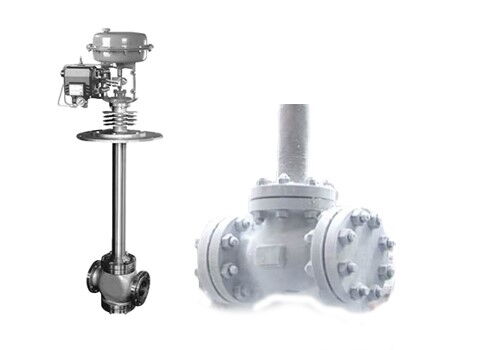How to Best Install and Use Low-Temperature Control Valves
On this page
Low-temperature control valves are designed to operate in extremely cryogenic environments, typically ranging from -60°C to -196°C. These pneumatic or electric valves meet the specific demands of cryogenic applications for fluid control. Due to their unique working conditions, the installation and usage of cryogenic control valves differ significantly from standard temperature and high-temperature control valves. To ensure their reliability and safety in practical use, the following detailed introduction outlines the precautions for installation and the design features of low-temperature control valves.
Proper preparation before installing a low-temperature control valve is crucial and includes the following aspects.
Before installation, conduct a thorough inspection of all valve components to ensure they are intact and not loose. Pay special attention to the condition of critical parts such as the valve body, stem, and seals. If any damaged or substandard components are found, replace them promptly to avoid failures during operation.
For valves handling hazardous materials, rigorous testing for strength, sealing, leakage, and precision is necessary. These tests ensure that the valve can operate safely and reliably under extreme conditions, reducing potential safety risks.
Before installation, thoroughly clean the piping and valve to remove impurities and grease. In oil-free environments, specific cleanliness requirements should be clearly stated. Cleaning not only improves the valve's operational efficiency but also extends its lifespan.
When choosing lubricants, consider the compatibility with the working medium to avoid accidents. Selecting the right lubricant can effectively reduce friction and ensure the valve's flexibility and stability.
During the actual installation, focus on the following key aspects to ensure the normal operation of the cryogenic control valve.
Ensure the coaxiality of the flanges when connecting the valve body to the piping to prevent leaks or valve failure due to improper alignment. It is recommended to use flexible connections between the valve cover and the cold box to reduce stress caused by temperature changes and prevent material deformation or cracking.
The chosen installation site should prioritize the safety of personnel and equipment, ensuring convenience for future disassembly and maintenance. Maintain good ventilation to avoid safety hazards caused by gas accumulation.
The valve should be installed upright and vertically on horizontal piping. It may be tilted if necessary, but if the valve is not vertically aligned or subject to vibration, it must be supported to prevent failure from gravity or vibration. Also, consider the valve's weight and the piping's load-bearing capacity to avoid deformation or damage.
The flow direction of the medium must align with the arrow on the valve body to ensure a proper flow path. Ensure the airflow is dry and free of oil to avoid negatively affecting the performance of the cryogenic control valve. The working temperature of the valve should be maintained between -30°C and 60°C for stable operation.
To ensure continuous production during control system failures or valve maintenance, a bypass should be set up, with the bypass valve's flow characteristics and travel matching those of the original valve. This ensures system continuity and stability. The design of the bypass valve should allow for quick response to avoid production interruptions during valve maintenance.
The design of cryogenic control valves addresses the special needs of extreme low-temperature environments, featuring several significant characteristics.
The use of long-neck valve covers provides insulation, resulting in a compact, lightweight valve structure while ensuring stability in cryogenic conditions. The long-neck design helps isolate the low-temperature medium, preventing thermal conduction to other valve components.
The valve body is typically made from precision-cast aluminum alloy, which offers excellent low-temperature performance and corrosion resistance, ensuring reliability under extreme conditions. Aluminum alloy is lightweight and strong, making it suitable for cryogenic applications.
The bellows sealing design effectively prevents leakage of cryogenic media, ensuring the sealing performance of the control valve during low-temperature operation. This sealing structure can withstand significant pressure differentials, maintaining good sealing even under high-pressure conditions.
Due to the unique structure of low-temperature control valves, adhere to the following special requirements during installation.
The stem direction should remain within a 45-degree range pointing straight up, avoiding installation on vertical piping. Otherwise, cryogenic media may fill the extended portion of the valve cover, leading to packing failure and potentially transferring cold to the valve handle, posing risks to operators.
For low-temperature valves with pressure relief structures, pay special attention to the required direction of relief during installation. The relief direction should be clearly marked on the process flow diagram and reflected in the isometric drawing of the piping. This step is critical. If necessary relief holes are not installed, liquid in the valve chamber may vaporize upon heating, potentially causing the valve body to burst. If the relief direction is incorrect, flammable or toxic process media could leak into the maintenance area, resulting in serious safety accidents.
The normal operation of low-temperature control valves relies on regular maintenance and inspection. A detailed maintenance plan should be established, including the following aspects.
Regularly inspect all components of the valve, including seals, stems, and actuators, ensuring they are intact and promptly replace worn or aging parts.
During maintenance, clean the valve and its surrounding environment to ensure no impurities or oil residues remain. Cleaning not only improves the valve's efficiency but also extends its lifespan.
Conduct regular performance tests to ensure the valve operates efficiently and responsively in extremely cryogenic environments, promptly identifying and addressing potential issues.
In summary, low-temperature control valves require a high level of professionalism and complexity in their installation and use. It is essential to strictly adhere to relevant regulations and precautions to ensure their safety and reliability in extreme environments. Through proper design, standardized installation, and regular maintenance, potential risks associated with cryogenic control valves can be effectively minimized, ensuring the stability and safety of production processes. For industries involving cryogenic processes, such as liquid nitrogen, liquid helium, and other deep cryogenic applications, the selection, installation, and maintenance of low-temperature control valves are critical elements that should not be overlooked.

